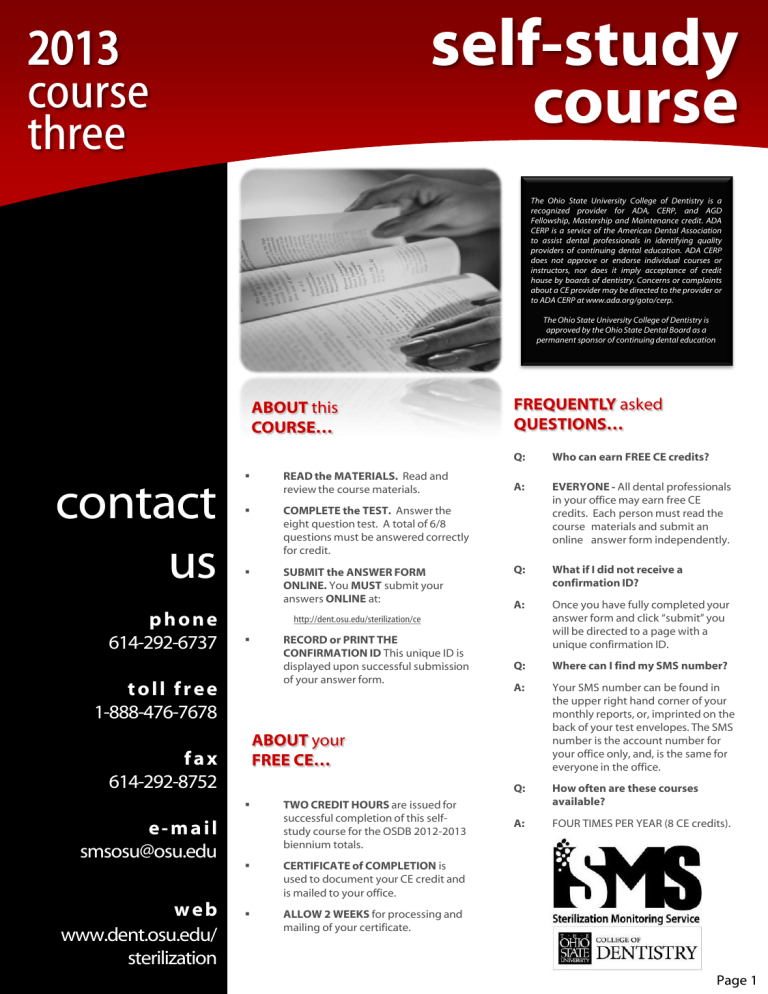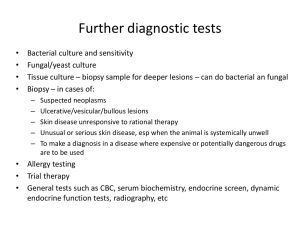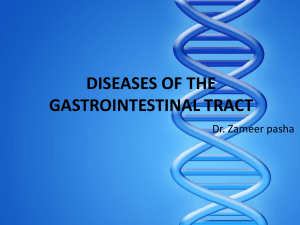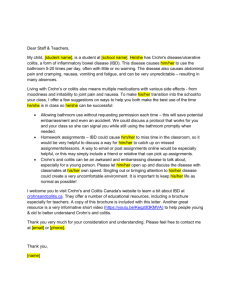
self-study course 2013 course three The Ohio State University College of Dentistry is a recognized provider for ADA, CERP, and AGD Fellowship, Mastership and Maintenance credit. ADA CERP is a service of the American Dental Association to assist dental professionals in identifying quality providers of continuing dental education. ADA CERP does not approve or endorse individual courses or instructors, nor does it imply acceptance of credit house by boards of dentistry. Concerns or complaints about a CE provider may be directed to the provider or to ADA CERP at www.ada.org/goto/cerp. The Ohio State University College of Dentistry is approved by the Ohio State Dental Board as a permanent sponsor of continuing dental education ABOUT this COURSE… contact us phone 614-292-6737 READ the MATERIALS. Read and review the course materials. COMPLETE the TEST. Answer the eight question test. A total of 6/8 questions must be answered correctly for credit. SUBMIT the ANSWER FORM ONLINE. You MUST submit your answers ONLINE at: Who can earn FREE CE credits? A: EVERYONE - All dental professionals in your office may earn free CE credits. Each person must read the course materials and submit an online answer form independently. Q: What if I did not receive a confirmation ID? A: Once you have fully completed your answer form and click “submit” you will be directed to a page with a unique confirmation ID. RECORD or PRINT THE CONFIRMATION ID This unique ID is displayed upon successful submission of your answer form. Q: Where can I find my SMS number? A: Your SMS number can be found in the upper right hand corner of your monthly reports, or, imprinted on the back of your test envelopes. The SMS number is the account number for your office only, and, is the same for everyone in the office. Q: How often are these courses available? A: FOUR TIMES PER YEAR (8 CE credits). ABOUT your FREE CE… fax 614-292-8752 web www.dent.osu.edu/ sterilization Q: http://dent.osu.edu/sterilization/ce toll free 1-888-476-7678 e-mail smsosu@osu.edu FREQUENTLY asked QUESTIONS… TWO CREDIT HOURS are issued for successful completion of this selfstudy course for the OSDB 2012-2013 biennium totals. CERTIFICATE of COMPLETION is used to document your CE credit and is mailed to your office. ALLOW 2 WEEKS for processing and mailing of your certificate. Page 1 2013 course three GASTROINTESTINAL DISEASE WITH ORAL INVOLVEMENT This self-study covers a few gastrointestinal diseases that present with characteristic oral findings. The objective is to introduce healthcare professionals to some of the more common oral manifestations of gastrointestinal diseases. INTRODUCTION It is not uncommon to find oral manifestations of systemic diseases. Skin, hematopoietic and gastrointestinal diseases show frequent oral involvement. Systemic disorders may present with dental and oral mucosal changes (see Table 1). In rare instances, these changes may be the only or initial presentations of an underlying systemic disease. Accurate identification and diagnosis of these alterations by oral health professionals can allow them to assist their patients in seeking appropriate medical care. written by amber kiyani, dds edited by taylor eiford mei-ling shotts, bs karen k. daw, mba, cecm Since the oral cavity constitutes the proximal end of the gastrointestinal tract, diseases of the gastrointestinal system may exhibit oral manifestations. Gastroenterologists receive inadequate training in evaluating the oral cavity, thus disabling them from recognizing changes in oral mucosal and mineralized tissues. Oral health professionals have a closer association with the oral cavity and are adept at identifying pathological changes in the mouth. In order to assist the patient to seek appropriate medical attention, it is essential for the oral health professional to familiarize themselves with some of the more common changes seen in the oral cavity in patients with gastrointestinal disease. Source: virtualmedicalcentre.com INFLAMMATORY BOWEL DISEASE Inflammatory bowel disease is a group of idiopathic conditions that cause chronic inflammation of the gastrointestinal tract. The two major subtypes of the condition are Crohn’s disease and ulcerative colitis. In the United States the disease involves over 2% of the population affecting people in any age group. The oral manifestations of inflammatory bowel disease are not rare and in some instances may be the first presentations of the disease. Oral involvement with Crohn’s disease is reported to range between 40 and 60% while ulcerative colitis may be present in up to 6% of the patients. Page 2 TABLE 1 Type of Disorder Diseases that may involve oral cavity 1. Granulomatous Sarcoidosis, Crohn’s Disease 2. Immunologic Vesico-bullous processes (lichen planus, pemphigus, pemphigoid, erythema multiforme, erythema migrans, chronic ulcerative stomatitis, psoriasis, lupus, systemic sclerosis), Lichenoid mucositis, Orofacial granulomatosis, Wegener’s granulomatosis, Behcet’s syndrome, Aphthous ulceration 3. Hematologic Anemia, Cyclic neutropenia, Thrombocytopenia, Leukemia, Langerhans Cell Histiocytosis, Lymphoma, Mycosis fungoides, Plasmacytoma, Plasminogen deficiency 4. Microbial Actinomycosis, Diphtheria, Syphilis, Tuberculosis, Leprosy, Noma, Cat-scratch disease, Streptococcal pharyngitis, Candidiasis, Histoplasmosis, Blastomycosis, Coccidioidomycosis, Cryptococcosis, Toxoplasmosis, Aspergillosis, Herpes simplex, Varicella Zoster virus, Infectious mononucleosis, Cytomegalovirus, Enterovirus, Rubeola, Rubella, HIV 5. Gastrointestinal Crohn’s disease, Ulcerative colitis, Gardner syndrome, Peutz-Jegher syndrome, Gastric reflux, Jaundice 6. Skin Ectodermal dysplasia, White sponge nevus, Hereditary benign intraepithelial keratosis, Pachyonychia congenita, Dyskeratosis congenita, Xeroderma pigmentosum, Hereditary mucoepithelial dysplasia, Incontinentia pigmenti, Darier’s disease, Hereditary hemorrhagic telangiectasia, Ehler-Danlos syndromes, Tuberous sclerosis, Multiple hamartoma syndrome, Epidermolysis bullosa 7. Endocrine Diabetes mellitus, Hypothyroidism, Addison’s disease, Hyperparathyroidism 8. Metabolic Amyloidosis, Lipoid proteinosis 9. Genetic Crouzon’s syndrome, Apert syndrome, Mandibulofacial dysostosis 10. Nutritional Folic acid deficiency, Iron deficiency Page 3 CROHN’S DISEASE Crohn’s disease or regional enteritis is an idiopathic inflammatory disorder that may involve any part of the gastrointestinal system from mouth to the anus. Abdominal cramps, diarrhea, nausea, weight loss and malnutrition are common symptoms of the disease. Oral lesions may be seen in 40-60% of Crohn’s patients. In about 30% of the cases oral lesions may be the initial presentation of disease. It is important for oral health professionals to recognize these lesions so they can guide their patients to seek appropriate medical care. ORAL PRESENTATION Linear Vestibular Ulceration Linear vestibular ulceration is seen along the lower buccal vestibule. The ulcers are persistent in nature and characteristically deep and ragged in appearance. The ulcers usually occur bilaterally and are symmetrical. They may result in significant discomfort forcing the patient to seek medical attention. Oral Crohn’s Disease Source: gastrolab.net Mucosal Tags Mucosal tags resembling denture related fibrous hyperplasia, or epulis fissuratum, may be identified in patients with Crohn’s disease. The size of the lesions can vary considerably. Aphthous Ulceration Mucogingivitis Major and minor aphthae are a reported oral finding in patients with Crohn’s disease. The ulcers involve mucosa that is not firmly bound to the underlying bone, buccal and labial mucosa, tongue, soft palate and the floor of the mouth. They range in size from 0.2 to 3 cm and appear as round to oval lesions with a red halo around them. The ulcers cause significant discomfort, especially in association with consumption of acidic or spicy foods. The ulcers heal over a period of 2-3 weeks. Mucogingivitis appears as diffuse, erythematous macules involving the gingiva. In some instances, it may present as hyperplastic plaques involving attached and unattached gingiva. Aphthous ulcers are not specific to Crohn’s disease. Their significance in this context remains uncertain since they may also be seen in the healthy population. Mucosal Swelling Granulomatous cheilitis is a term used to refer to an uncommon condition resulting in chronic indurated swelling of the lips that may be seen in patients with Crohn’s disease. The swelling is persistent and is usually not associated with pain. Patients tend to seek medical attention for cosmetic reasons. Cobblestoning, or nodular swelling of the gingiva and buccal mucosa, is another feature attributed to Crohn’s disease. ULCERATIVE COLITIS Ulcerative colitis is a disease of the colon characterized by the presence of large ulcers. The most common symptom includes a progressively increasing bloody diarrhea. Oral involvement with ulcerative colitis is rare, and may be seen in less than 2% of the patients. Pyostomatitis Vegetans Pyostomatitis vegetans is commonly linked to ulcerative colitis. It presents in the mouth as multiple white or yellow, “serpentine” pustules that rupture easily to form snail track ulcers. While the lesions are more frequent on the palate and gingiva, any site in the oral cavity may be involved. The eruptions develop quickly over a period of days and may coincide with a flare of the bowel disease. Page 4 DIAGNOSIS erosion that is localized to the inner surface of the anterior maxillary dentition. Crohn’s Disease A prior history of disease and the characteristic appearance of the lesions may be sufficient for diagnosis in some instances. In cases where gastrointestinal disease is not present or not identified, a biopsy of the oral lesions is necessary. Identification of granuloma formation on histopathology is highly suggestive of Crohn’s disease. TREATMENT Once the diagnosis of erosion is made, it is pertinent for the dentist to determine the reason for it. Referral to a gastroenterologist may be required to address this concern. In the event that the patient is already under the care of a gastroenterologist, the dentist needs to make sure that the physician is made aware of the situation. MALABSORPTION Ulcerative Colitis History of disease and biopsy of the affected tissue with direct immunofluorescence testing is sufficient to establish diagnosis. Gastrointestinal diseases and elective gastrectomy may lead to nutritional imbalances that impair the hematopoietic system and have an effect on oral tissues. ORAL PRESENTATION Iron deficiency anemia and pernicious anemia may manifest themselves as atrophic glossitis, a condition characterized by loss of papillae from the dorsum surface of the tongue leaving a bald, red tongue. Milder cases are associated with a more patchy distribution on the depapillated areas. In severe cases, persistent ulceration may occur and the red patches may involve other oral tissues. The patients with atrophic glossitis present with a sore and burning sensation of the tongue. Oral lesions in ulcerative colitis Source Dr. Kiyani DIAGNOSIS Blood tests are required to measure iron and vitamin B12 levels. TREATMENT Treating the bowel disease usually leads to complete resolution of the oral lesions for both Crohn’s disease and ulcerative colitis. GASTRIC REFLUX Acid regurgitation is a common symptom in patients with gastroesophageal reflux disease (GERD), hiatal hernia, alcoholism and bulimia that may produce identifiable changes in teeth. ORAL PRESENTATION Acid regurgitation may result in enamel erosion in patients with these conditions. The enamel is lost from the areas exposed to the acid producing shiny and hard surfaces. In chronic cases, the enamel is completely eroded to expose the underlying dentin, making the teeth sensitive to temperature changes. Bulimic patients exhibit a characteristic pattern of ….. TREATMENT Restoration of iron and vitamin B12 levels results in regeneration of the tongue papilla and complete resolution of the condition. BEHCET’S SYNDROME Behcet’s syndrome is a multisystem autoimmune disorder that primarily involves the orogenital and ocular regions. Cutaneous lesions, arthritis and involvement of the central nervous system have also been reported with this condition. The affected population may frequently have a Mediterranean or Japanese lineage. The condition is commonly diagnosed in young adults. Page 5 ORAL PRESENTATION The oral lesions of Behcet’s syndrome may be an initial presentation and are noted in over 99% of the affected population. The lesions bear a close resemblance to aphthous ulceration. Soft palate and the oropharynx are common sites of involvement. Six or more ulcers may be seen at one time. The ulcers may vary in size, have a ragged border and may be surrounded with a larger erythematous ring. DIAGNOSIS There is no definitive test available for diagnosis of Behcet’s syndrome. A diagnostic criterion has been put forward by the International Study Group. Premolar and molar regions are rarely affected. Supernumerary teeth impede the eruption pathway for normal dentition resulting in multiple un-erupted incisors and canines. Osteomas Osteomas are benign, slow growing bony tumors composed of well differentiated and densely sclerotic compact bone that are common to the skull and facial bones. In patients with the syndrome, multiple osteomas are seen in the jaws and the sinuses. When gnathic lesions are seen, they commonly affect the angle of mandible. They cause focal expansion of the bones that can be palpated through the skin or oral mucosa. Osteomas can grow large enough to cause significant deformity and interfere with function. Surgical removal is the treatment of choice. Epidermoid cysts Ulcer due to Behcet’s Syndrome Source: Dr. Kiyani Epidermoid cysts are also referred to as sebaceous cysts, a misnomer since it has no connection to sebaceous glands. These are formed by the implantation of the epidermis into the dermis. They appear as painless, raised, well demarcated, round and subcutaneous bumps. Patients with the syndrome tend to develop multiple epidermoid cysts on the facial skin and scalp. They can grow to be quite large and may become a cosmetic concern. They can be removed surgically. GARDNER SYNDROME PEUTZ-JEGHERS SYNDROME Gardner syndrome is an autosomal dominant disease characterized by multiple intestinal polyps and a high risk of adenocarcinoma. Extracolonic manifestations of the disease are seen in multiple organs including skin, skeleton and soft tissues. Peutz-Jeghers Syndrome, or hereditary intestinal polyposis, is a genetic disease characterized by development of multiple benign polyps in the intestines and melanin deposition. ORAL PRESENTATION Enostoses An enostosis is a bony growth within a bone cavity or on the internal surface of the bone cortex. Patients with Gardner syndrome show multiple enostoses in the jaws that can be identified on radiographs. Alveolar bone serves as a common site for occurrence. These bony lesions are painless and produce no expansion. The condition usually requires no medical or surgical intervention. Supernumerary Teeth: Patients with Gardener syndrome tend to have multiple supernumerary teeth in the anterior portion of the jaws. ORAL PRESENTATION Flat, painless, black or brown macules are seen on the lips, oral mucosa, perioral skin, dorsa of fingers and toes. The lesions appear shortly after birth and range in size from 1-5mm. Labial mucosa, buccal mucosa, gingiva and hard palate serve as common sites for occurrence intraorally. DIAGNOSIS Diagnosis is primarily made clinically on the basis of a positive medical history, presence of the characteristic pigmentation and hamartomatous polyps. Over 90% of patients with clinical disease present with a genetic mutation that can now be identified using molecular testing. ………….. Page 6 TREATMENT ORAL PRESENTATION The lesions require treatment for cosmetic reasons. Laser ablation has shown promising results in treatment of this condition. The lesions appearing in the oral cavity resemble those of the esophagus and vary in size from 2-10 mm. Buccal mucosa and tongue have been reported as the most common sites of involvement. DIAGNOSIS A biopsy of the oral lesion is usually sufficient to establish diagnosis. An endoscopy can be carried out to view and biopsy the esophageal lesions. TREATMENT The lesions are harmless and show no significant growth potential. No treatment is usually necessary. Peutz-Jeghers Syndrome Source: hshsl.umaryland.edu JAUNDICE Excess bilirubin in blood causes accumulation of bilirubin in tissues. ORAL PRESENTATION Jaundice may result in yellow discoloration of the skin, whites of the eyes, sclera and oral mucosa. The severity of the yellow discoloration is dependent on the amount of accumulated bilirubin and the duration of the disease. Intraorally, lingual frenum and soft palate are more severely involved. However, yellow discoloration of the soft palate is not diagnostic for jaundice, since similar discoloration patterns may be seen in people consuming large amounts of vitamin A. DIAGNOSIS Liver Function Tests (LFTs) in patients with jaundice show altered liver enzymes and excess bilirubin. TREATMENT Resolution of liver disease restores oral tissues to their original colors. GLYCOGENIC ACANTHOSIS Glycogenic acanthosis is a benign esophageal lesion that appears as small, white and raised plaques. A few reports of intraoral involvement with this process are available in recent literature. METASTATIC DISEASE Malignant neoplasms of the gastrointestinal system may occasionally metastasize to the oral cavity through a hematogenous route. The posterior mandible usually serves as a common site of involvement. Less commonly the maxilla and soft tissues may be involved. ORAL PRESENTATION The lesions are very rarely asymptomatic. In most cases the patient complains of pain, paresthesia or tooth loss. Soft tissue lesions may appear as exophytic growths exhibiting ulceration in some instances. Bone involvement presents as an irregular and poorly circumscribed radiolucency. Multifocal involvement may occur in some cases. DIAGNOSIS A biopsy is necessary to establish diagnosis. The pathologist performs immunohistochemistry staining to trace the origin of the malignancy. TREATMENT Metastasis to the jaw is an indicator for poor prognosis. Palliative care is usually the only choice of treatment at this stage of the disease. HEMOCHROMATOSIS Hemochromatosis is defined as iron overload with a hereditary or metabolic origin. Oral changes are observed in 15-25% of patients with this condition. Bluish gray pigmentation of the palate and gingiva is noted. Page 7 CONCLUSION Many gastrointestinal diseases have been reported to produce very characteristic mucosal or dental alterations in the oral cavity. Dental professionals should be equipped with the knowledge and skills to identify these lesions so they can assist their patients in seeking appropriate care. A complete oral examination comprises the following steps • An extra-oral inspection of the face and neck regions to look for any enlargements, lesions or obvious asymmetries. • Extra-oral palpation of the salivary glands to feel for abnormal masses. • Palpating lymph nodes to rule out lymphadenopathy. • Palpating the TMJ for clicking, crepitus, popping or deviation on opening. References 1. Neville BW, Damm DD, Allen CM, Bouqout JE. Oral and Maxillofacial Pathology. 3rd ed. 2. Daley TD, Armstrong JE. Oral manifestations of gastrointestinal diseases. Can J Gastroenterol 2007; 21:241-4. 3. Beitman RG, Frost SS, Roth JL. Oral manifestations of gastrointestinal diseases. Dig Dis Sci 1981; 26:741-7. 4. Handlers JP. Oral manifestations of gastrointestinal diseases. J Calif Dent Assoc. 1999; 27(4):311-7. • Examining the lips for any lesions, color changes or masses. • Inspecting and palpating labial and buccal mucosa for any lesions or obvious masses. • Inspecting the palatal mucosa and palpating for any obvious masses. • Inspecting the oropharynx for any asymmetries. • Inspecting the tongue for any lesions or asymmetries, palpate the tongue to feel for any masses. • Inspecting the floor of mouth for any lesions or asymmetries, palpate the floor of mouth using bimanual palpation to feel for any masses. • Inspecting the gingiva for signs of inflammation, lesions or asymmetries. • Inspecting and palpating the alveolar bones for any protrusions. ORIGINATING FROM PAKISTAN, DR. KIYANI WENT TO RIPHAH UNIVERSITY FOR THEIR 5-YEAR DENTAL SCHOOL PROGRAM. GRADUATING WITH A 4.0 GPA, SHE CAME TO THE OHIO STATE UNIVERSITY IN ORDER TO FURTHER HER STUDIES FOCUSING ON ORAL AND MAXILLOFACIAL PATHOLOGY. SHE PLANS TO TAKE THE INFORMATION SHE LEARNS BACK TO PAKISTAN FOR BOTH DIAGNOSTIC AND TEACHING PURPOSES. HER CURRENT RESEARCH STUDIES AS A FELLOW AT OSU INVOLVE EVALUATING THE ORAL CHANGES ASSOCIATED WITH GASTROINTESTINAL DISEASES. DR. AMBER KIYANI CAN BE CONTACTED • Examining the dentition to complete the exam. AT: KIYANI.1@OSU.EDU • Making a note of any suspicious findings and ensuring that an expert takes a look at the area of concern. Page 8 post-test instructions - answer each question ONLINE press “submit” record your confirmation id deadline is August 2, 2013 1 T F Consuming large amounts of Vitamin A could result in a false positive for Peutz-Jeghers Syndrome. 2 T F GERD stands for gastroesophageal reflux disease. F Multiple enostoses of the jaw associated with Gardner Syndrome can not be identified on radiographs. F Resolution of oral lesions for Ulcerative Colitis and Crohn’s Disease is usually a direct result of treating these diseases. SUBMIT ONLINE SUBMIT ONLINE 3 4 5 6 7 8 T T T T T T F F A complete oral examination includes palpating salivary glands, alveolar bones, TMJ, and the lymph nodes. Hemochromatosis and Jaundice are due to iron overload with a metabolic or hereditary origin. F Gastroenterologists in the United States do not receive adequate training in evaluating the oral cavity. F Epidermoid cysts, also referred to as sebaceous cysts, are connected to the sebaceous glands. director carl m. allen, dds, msd allen.12@osu.edu assistant director karen k. daw, mba, cecm daw.37@osu.edu program assistant rikki hedges, ba hedges.116@osu.edu lab technician mei-ling shotts, bs shotts.5@osu.edu Page 9




